Chapter 18.150
PORT PENINSULA
Sections:
18.150.020 Design guidelines.
18.150.030 Site design - Pedestrian connections.
18.150.040 Site design - Lighting.
18.150.050 Site design - View corridors.
18.150.060 Building design - Creation of human scale.
18.150.070 Building design - Color and materials.
18.150.080 Landscape design.
18.150.090 Building design - Landscape design - Suitability of materials.
18.150.100 Signs - Attached to the building.
18.150.110 Signs - Freestanding signs.
(Ord. 6306 §9, 2004).
18.150.020 - Design Guidelines
The following guidelines apply to the Port of Olympia’s Urban Waterfront-zoned properties on the Port Peninsula, and are the only City design guidelines which apply to the Port Peninsula. These guidelines were developed in a cooperative effort between the City and the Port. A map indicating the Urban Waterfront-zoned properties is shown on Figure 6A-53.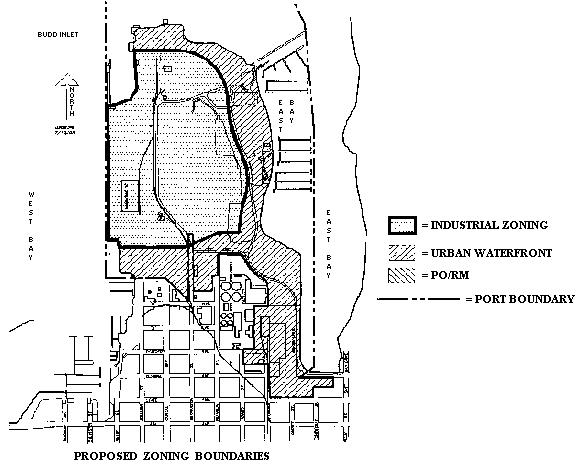
FIGURE 18.150.020
(Ord. 6306 §9, 2004).
18.150.030 - Site design –Pedestrian Connections
A. REQUIREMENT: Incorporate pedestrian access into the site plan where pedestrian access exists and where site security is not in questions.
B. GUIDELINE:
1. Incorporate cross-site pedestrian connections within projects where feasible.
2. Coordinate signing to facilitate movement of pedestrians through the site and vehicles around the site.
3. Provide walkways through parking bays and adjacent to planters.
4. Define walkways with vertical plantings, such as trees or shrubs.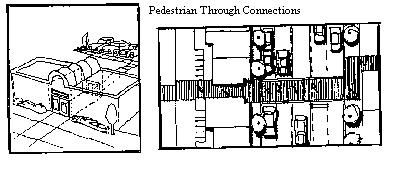
FIGURE 18.150.030
(Ord. 6306 §9, 2004).
18.150.040 - Site design –Lighting
A. REQUIREMENT: Accent structures, as well as provide visibility, security, and conserve energy with lighting.
B. GUIDELINE:
1. Use lighting to accent key architectural elements or to emphasize landscape features.
2. Add adequate lighting to sidewalks and alleys, to provide for well lighted pedestrian walkways in accordance with the Olympia Development Standards Table III, Lighting.
3. Locate lighting so as not to have a negative impact on adjacent properties such as shining off site into adjacent buildings.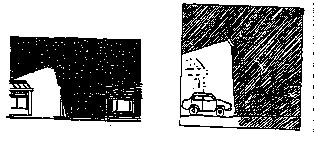
FIGURE 18.150.040
(Ord. 6306 §9, 2004).
18.150.050 - Site Design –View Corridors
A. REQUIREMENT: Provide for public view corridors of the Capitol Building, Olympic Mountains and Budd Inlet.
B. GUIDELINE:
1. Intermittent or partial views to the scenic vistas mentioned above may not be deemed necessary to incorporate into the site and building design.
2. Refer to the Scenic Vista overlay zoning maps available at the Community Planning and Development Department.
(Ord. 6306 §9, 2004).
18.150.060 - Building Design –Creation of Human Scale
A. REQUIREMENT: Use design elements that result in buildings with a perceived size that maintains a human scale street that is comfortable for pedestrians and attractive to them.
B. GUIDELINE:
1. Use articulation on building facades to achieve smaller building massing. Methods include:
a. Modulation;
b. Broken rooflines; and
c. Building elements such as balconies, chimneys, porches or other entry details, and landscaping.
Rooflines can reinforce the architectural character of a street.
FIGURE 18.150.060-A
Architectural features like cornices can relate to adjacent buildings, lowering the apparent, conflicting height of the building.
FIGURE 18.150.060-B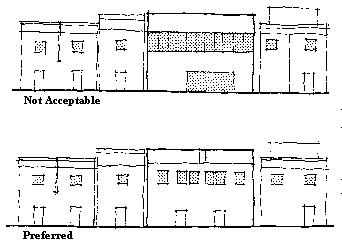
FIGURE 18.150.060-C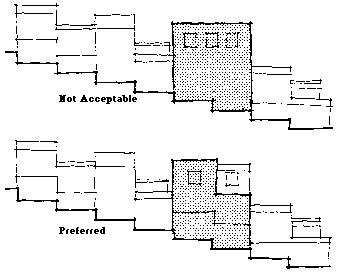
The pattern and proportion of windows, doors and other glazed areas (fenestration) is important in determining the buildings architectural character. Following the proportion and pattern of neighboring buildings will increase the consistency of the overall streetscapes.
FIGURE 18.150.060-D
This building is articulated into intervals. Articulation methods include modulation, broken rooflines, building elements (chimneys, entries, etc.) and landscaping.
FIGURE 18.150.060-E
(Ord. 6306 §9, 2004).
18.150.070 - Building Design –Color and Materials
A. REQUIREMENT: Using appropriate color and material on new and remodeled buildings. Use subdued colors on exterior building walls and large surfaces.
B. GUIDELINE:
1. Reserve bright colors for trim or accents.
2. Avoid large expanses of highly tinted or mirrored glass (except stained-glass windows). Use of tinted glass as an accent is acceptable.
3. Avoid use of reflective exterior materials (except windows) where glare would shine into nearby buildings.
(Ord. 6306 §9, 2004).
18.150.080 - Landscape Design
A. REQUIREMENT: Use plants as screening, canopy, and as space defining elements.
B. GUIDELINE:
1. Plantings and paving can serve to define the appropriate location for pedestrian and vehicle traffic.
2. Plantings such as street trees, hedges and screening hedgerows can be used to create and reinforce the functional definition of the site plan.
3. Repeating landscape material throughout the project can unify the development.
4. Parking lots can be divided into smaller lots with separations created by grouping landscaping and trees as buffers between parking areas. Where large planting areas are impractical or inefficient, canopy tress can be planted in protected planting locations.
(Ord. 6306 §9, 2004).
18.150.090 - Building Design –Landscape Design –Suitability of Materials
A. REQUIREMENT: Plant materials shall be suited to the climate and at their mature, natural size, suitable for their planting location.
B. GUIDELINE:
1. Select trees for parking lots and sidewalk areas which do not interfere with the visibility and movement of vehicles or pedestrians.
2. Avoid trees which may create problems by dropping fruit or seeds, have brittle wood, and/or cause pavement or other hard surfaces to heave.
3. Use shrubs or vines trained to grow upright on wires or trellises (espaliers) next to blank walls with narrow planting areas.
4. Projects must also comply with the adopted Street Tree Plan, and the Landscaping and Screening Chapter of the Olympia Zoning Code 18.36 for more information on landscaping requirements.
5. Choose hardy plant materials that can survive the effects of building or large paved areas (in terms of heat, shade, wind, etc.)
FIGURE 18.150.090
(Ord. 6306 §9, 2004).
18.150.100 - Signs-Attached to the Building
A. REQUIREMENT: Provide adequate signage for businesses while maintaining the buildings architectural integrity, by locating signs so that building details shall not be covered or obscured. Signs will conform to the Olympia Zoning Ordinance Sign Code (OMC Chapter 18.42, Signs).
B. GUIDELINE:
1. Use sign panel shapes that accentuate buildings architectural forms.
2. Keep signs subordinate to the building design.
3. Coordinate colors with the colors of building.
4. Avoid a wide variety of types and sizes of signs when several businesses share the same building. Use directory signs where possible.
5. Reinforce the overall composition of the facade by selecting colors, materials, size and shape, and method of illumination, as found on adjacent properties. Emphasize legibility and simplicity. Locate signs in the overall facade composition, as found on adjacent properties.
6. Align signs with those on adjacent buildings when possible.
7. Design sign for businesses served principally by vehicular traffic to be easily legible form the street.
8. Addresses must be clearly visible, in accordance with OMC Chapter 12.48.120(C)
9. Select lettering sizes which could be more visible to the pedestrian than to vehicular traffic in pedestrian oriented areas of the site. Limit the number of letters styles to one (1) or two (2).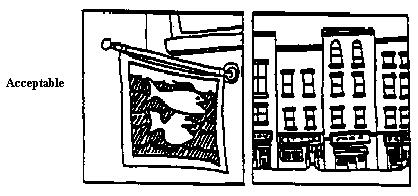
FIGURE 18.150.100
(Ord. 6306 §9, 2004).
18.150.110 - Signs –Freestanding Signs
A. REQUIREMENT: Provide adequate signage for businesses when building mounted signs cannot be used because they will obscure the architectural details of the building. Signs will conform to the Olympia Zoning Ordinance Sign Code (OMC Chapter 18.42, Signs).
B. GUIDELINE:
1. Freestanding signs should be limited in size and height. The maximum height should be forty-two (42) inches above grade.
2. For visual clarity, the lettering style and colors should be limited to two (2) lettering styles and three (3) colors.
3. Incorporate signs in planters or as screening walls.
4. The map designated "Allowed Building Heights In the Urban Waterfront Zone" set forth on p. 81 of the Final Supplemental Environmental Impact Statement hereby replaces Figure 6-2, of the Unified Development Code.
5. That the official City of Olympia Zoning Map, set forth in the Unified Development Code, is hereby amended to conform to the "Proposed Port Zoning" map on p. 77 of the Final Supplemental Environmental Impact Statement, insofar as same is applicable.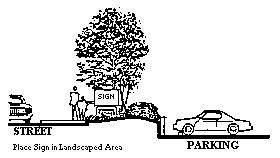
FIGURE 18.150.110
(Ord. 6306 §9, 2004).


